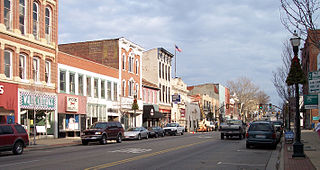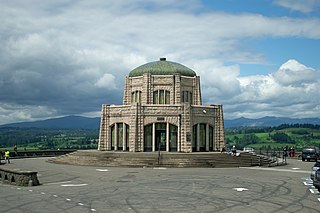
Burton Stephen Lancaster was an American actor and producer. Initially known for playing tough guys with a tender heart, he went on to achieve success with more complex, and challenging roles over a 45-year career in films and television series. He was a four-time nominee for the Academy Award for Best Actor, and he also won two BAFTA Awards and one Golden Globe Award for Best Lead Actor. The American Film Institute ranks Lancaster as #19 of the greatest male stars of classic Hollywood cinema.

The Columbia River is the largest river in the Pacific Northwest region of North America. The river forms in the Rocky Mountains of British Columbia, Canada. It flows northwest and then south into the U.S. state of Washington, then turns west to form most of the border between Washington and the state of Oregon before emptying into the Pacific Ocean. The river is 1,243 miles long, and its largest tributary is the Snake River. Its drainage basin is roughly the size of France and extends into seven states of the United States and one Canadian province. The fourth-largest river in the United States by volume, the Columbia has the greatest flow of any North American river entering the Pacific. The Columbia has the 36th greatest discharge of any river in the world.

Lancaster is a city in and the county seat of Fairfield County, Ohio, in the south-central part of the state. As of the 2020 census, the city population was 40,552. The city is near the Hocking River, about 33 miles (53 km) southeast of Columbus and 38 miles (61 km) southwest of Zanesville. It is part of the Columbus metropolitan area.

The Tlingit are indigenous peoples of the Pacific Northwest Coast of North America. Their language is the Tlingit language, in which the name means 'People of the Tides'. The Russian name Koloshi or the related German name Koulischen may be encountered referring to the people in older historical literature, such as Grigory Shelikhov's 1796 map of Russian America.

The Cascade Range or Cascades is a major mountain range of western North America, extending from southern British Columbia through Washington and Oregon to Northern California. It includes both non-volcanic mountains, such as many of those in the North Cascades, and the notable volcanoes known as the High Cascades. The small part of the range in British Columbia is referred to as the Canadian Cascades or, locally, as the Cascade Mountains. The highest peak in the range is Mount Rainier in Washington at 14,411 feet (4,392 m).

Charles Bulfinch was an early American architect, and has been regarded by many as the first American-born professional architect to practice.

The Residence Act of 1790, officially titled An Act for establishing the temporary and permanent seat of the Government of the United States, is a United States federal statute adopted during the second session of the 1st United States Congress and signed into law by President George Washington on July 16, 1790. The Act provides for a national capital and permanent seat of government to be established at a site along the Potomac River and empowered President Washington to appoint commissioners to oversee the project. It also set a deadline of December 1800 for the capital to be ready, and designated Philadelphia as the nation's temporary capital while the new seat of government was being built. At the time, the federal government operated out of New York City.

The Latin adverb sic inserted after a quoted word or passage indicates that the quoted matter has been transcribed or translated exactly as found in the source text, complete with any erroneous, archaic, or otherwise nonstandard spelling, punctuation, or grammar. It also applies to any surprising assertion, faulty reasoning, or other matter that might be interpreted as an error of transcription.

The Philadelphia and Lancaster Turnpike, first used in 1795, is the first long-distance paved road built in the United States, according to engineered plans and specifications. It links Lancaster, Pennsylvania, and Philadelphia at 34th Street, stretching for sixty-two miles. It was later extended by the Lancaster and Susquehanna Turnpike to the Susquehanna River in Columbia. The route is designated Pennsylvania Route 462 from the western terminus to US 30, where that route takes over for the majority of the route. The US 30 designation ends at Girard Avenue in the Parkside neighborhood of Philadelphia, where State Route 3012 takes it from there to Belmont Avenue. At Belmont Avenue, State Route 3005 gets the designation from Belmont Avenue until the current terminus at 34th Street. Historically, Lancaster Pike terminated at Market Street before Drexel University took over the stretch between 32nd and 34th Streets.

The history of Oregon, a U.S. state, may be considered in five eras: geologic history, inhabitation by native peoples, early exploration by Europeans, settlement by pioneers, and modern development.

Columbia Lancaster was an American lawyer and politician who served as the first Delegate from the Territory of Washington to the United States House of Representatives.

Vista House is a museum at Crown Point in Multnomah County, Oregon, that also serves as a memorial to Oregon pioneers and as a comfort station for travelers on the Historic Columbia River Highway. The site, situated on a rocky promontory, is 733 feet (223 m) above the Columbia River on the south side of the Columbia River Gorge. The octagonal stone building was designed by Edgar M. Lazarus in the style of Art Nouveau, and completed in 1918 after nearly two years of construction.

Chester Peter "Chess" Lyons was a Canadian outdoorsman and natural historian. The author of several books on the flora and landscape of the Pacific Northwest, Lyons is best known for his popular and widely cited botanical field guides.

This is a bibliography of works on the Provinces and territories of Canada.

For a useful starting point goto Oregon Encyclopedia of History and Culture (2022). Not yet in print format; it is online here with 2000 articles.
The following is a timeline of the history of Washington, D.C., the capital city of the United States.

Florence Yu Pan is an American attorney who serves as a United States circuit judge of the United States Court of Appeals for the District of Columbia Circuit. She is a former associate judge of the Superior Court of the District of Columbia and former United States district judge of the United States District Court for the District of Columbia.

Wildwood Restaurant and Bar, or simply Wildwood, was a Pacific Northwest and New American restaurant in Portland, Oregon, in the United States. Operating from 1994 to 2014, the restaurant earned owner and founding chef Cory Schreiber a James Beard Foundation Award nomination in the Best Chef: Northwest category. Wendy Culverwell of Portland Business Journal described Wildwood as "a pioneer in the farm-to-table food movement".

Northwest Oregon is a geographic and cultural region of the U.S. state of Oregon, composed of Clatsop, Columbia, and Tillamook counties. The region encompasses the northernmost parts of the state along the lower Columbia River.

Wiley Rutledge was nominated to serve as an associate justice of the Supreme Court of the United States by U.S. President Franklin D. Roosevelt on January 11, 1943, after the resignation of James F. Byrnes created a vacancy on the court. Per the Constitution of the United States, Rutledge's nomination was subject to the advice and consent of the United States Senate, which holds the determinant power to confirm or reject nominations to the U.S. Supreme Court. After being favorably reported on by both a subcommittee of the Senate Committee on the Judiciary and the full Judiciary Committee, the nomination was confirmed by the full Senate through a voice vote on February 8, 1943.




















